 |
Western chokecherry, Prunus
virginiana L. var. melanocarpa (A.
Nelson) Sarg. (left, right) grows in all Canadian provinces, and throughout
the United States except for the deep south. The western variety, var.
melanocarpa—the term means “black fruit”—is a
tall bush that flowers when it is only a foot or so tall. The plants usually
mature as tall bushes; rarely as trees as much as twenty feet high. The tart
but edible cherries are “drupes,” fleshy fruit, with seed-containing
pits. Lewis and Clark gathered specimens of western chokecherry twice, first
in September of 1804 in today’s South Dakota, and again on May 29, 1806,
while camped on the Clearwater River in today’s Idaho.
The eastern variety, var. virginiana differs in that it is
a sizeable tree that does not flower until mature. |
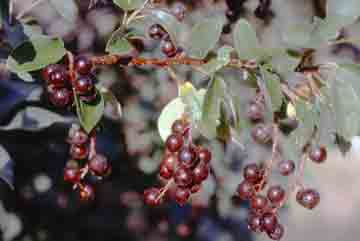 |
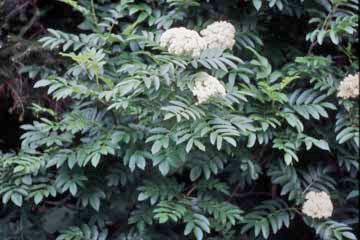 |
Mountain ash, Sorbus
scopulinus Greene (left, right)
is unrelated to the true ash of the eastern United States
(Fraxinus spp.). It is found in many parts of the West. Ours
is a small tree that bears clusters of white flowers in late spring, ripening
in late summer into colorful bunches of orange berries. Lewis and Clark collected
a fruiting specimen in 1805, during their journey west (September 2nd, on
the North Fork of the Salmon River) and again on Lolo Pass during their
homeward journey (June 27, 1806). The closely related and very similar Sitka
mountain ash, Sorbus sitchensis M. Roemer, is also found in Idaho,
although at higher elevations. |
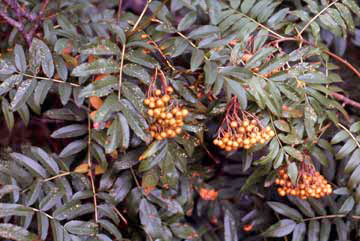 |
 |
Western serviceberry, Amelanchier
alnifolia (Nutt.) Nutt. ex M. Roemer
(left, right) The western serviceberry (also Saskatoon serviceberry) is an
attractive small tree that grows throughout northern North America to
mid-elevations. The species name alnifolia, means “alder-like
leaf.” Its deep blue berries are edible, although they have little taste.
Lewis and Clark collected a variety of the western serviceberry, var.
semiintegrifolia, at The Dalles in Oregon, and then, what may have
been this plant, var. alnifolia, in north central Idaho in the spring
of 1806. The name Amelanchier is derived from a Savoyard term for
the medlar-tree. Mespilus germanica.
It may be difficult to differentiate serviceberry from chokecherry
when they are not flowering or fruiting, The leaves of both are toothed,
but the service berry leaf is toothed only on the end. |
 |
 |
Black hawthorn, Crataegus
douglasii Lindl.
is found from the Dakotas to the Northwest, growing to
fairly high elevations. The trees may be identified by their long, sharp
thorns, rounded leaves with scalloped ends, clusters of white spring-blooming
flowers, and later by their dark-red, drying to black, fruit. The gnarled
trees have a heavy bark and grow as much as thirty feet high. Palatable,
but hardly delicious, “haws” were an important food for Native
Americans. Both this, and the similar red hawthorn, Crataegus
chrysocarpa, grow in Idaho—the latter as a cultivated plant. |
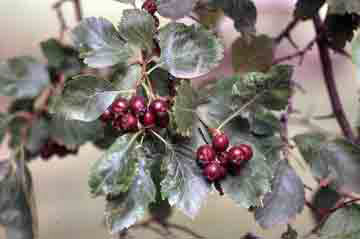 |
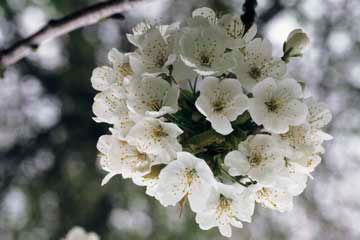 |
American wild plum, Prunus
americana Marshall
(left, right).The American wild plum is the tastiest of
all of our native Prunus species. As seen in the photographs, early
blooming flowers are arranged in an attractive cluster that appears before
the leaves are out. The fruit may be yellow, orange, or even, occasionally
red. Its lanceolate, serrated leaves are typical of Prunus species
in general. The American plum is widely distributed, found in almost all
of the United States with the exception of Oregon, Nevada, Texas and
California--and Idaho. Nevertheless, the trees grow in the foothills of the
Clearwater Mountains near Harpster, Idaho where this one was
photographed. Are they native? Or were they planted by settlers? Although
not reported from Idaho, it would not be surprising if these were native
trees, for Prunus americana grows nearby in western Montana and in
eastern Washington.
|
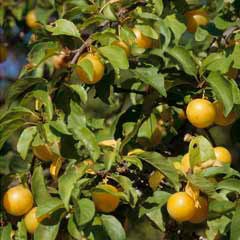 |









